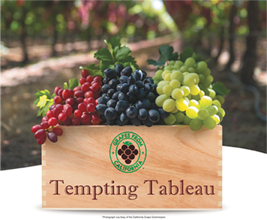The top volume export markets for Golden State grapes included Canada at 11.4 million boxes, followed by Mexico at 5.7 million, and China/Hong Kong at 5.5 million. Per capita consumption for the year was at 9.0 pounds in the United States; by comparison, U.S. per capita consumption in 1970 was only 2.5 pounds, a 360 percent increase in little more than a generation.
Competition, Imports and Exports
Thirty years ago, grapes were a summer treat, available only from May through October. With the world shrinking and demand growing for all varieties of fresh produce year round, suppliers began importing grapes from regions like South America with opposing seasons. Today, countries including Mexico, Peru and Chile keep North American produce departments well stocked with table grapes during the winter and early spring months.
For the most part, imports are complementary, helping to keep up demand. But there is competition from other countries as seasons overlap. Says Zaninovich, “Mexico is the most direct competition—their harvest starts the same time as Coachella Valley—May through June or July. During the middle of our domestic season, July through October, there’s not much competition.”
Jon P. Zaninovich, president and treasurer at Jasmine Vineyards, Inc. in Delano (a relation to above’s John Zaninovich) says, “The appearance of imported grapes decades ago initially elicited gloom and doom among California growers, but today imports have proven to increase overall consumption by making good quality available all year. We’re able to produce and sell over 110 million boxes per year out of California—the Table Grape Commission does a great job promoting the category. Now, there are daily shipments worldwide that enable us to move large crops, (hopefully) at a profit.”
With respect to competition, Nave says, “In May and June, California competes in the United States and in key markets around the world with Mexico, and with Chile as it ends its season; in December and January, competition within the United States is with Chile as it begins its season.”
When it comes to exports, competition ratchets up: “China is the biggest competitor in many Asian export markets,” Nave continues, adding, “but California also competes with grapes grown in Taiwan, Japan, South Korea, China, Australia, Spain, Italy, Greece, and other countries.” The Golden State’s exports are, nonetheless, impressive. “California exports 40 percent of its volume to 65 markets worldwide and 25 of those markets account for 90 percent of California exports.”
One might wonder, with such bumper crops, will the market still be able to absorb such quantities in North America and the rest of world? Nave seems to think so. “Looking ahead, we see the industry continuing to grow. Grapes are a preferred fruit among consumers,” she observes, “and California still has caché in many places. And, in many countries there is a growing middle class, so more people can afford imported grapes.”



